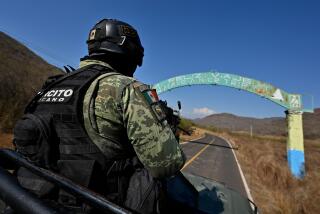Town’s Treasure Is the Ground, Not the Gold Beneath
- Share via
TAMBOGRANDE, Peru — Taking a break from running his parents’ restaurant, Javier Palacios strolls across the sleepy main square -- the spot that will become a huge mining pit if a Canadian company gets its way.
Lime and mango orchards sprawl in the hazy lowlands below the town. Palacios, a 33-year-old engineer, nods toward them: “We’ve been tied to agriculture for generations. We simply don’t want the mine and the change that it would bring.”
The farming community has been steadfast in fighting to keep the mineral treasure beneath its land where it is -- and away from the mining company.
In the process, it has become a case study in the conflicts that can arise from globalization, one in which powerful financial interests seeking profits collide with the will of a town determined to maintain its way of life.
The tale includes an unsolved murder, riots and looting, propaganda battles and a disputed referendum. The Roman Catholic Church has weighed in with the mine’s opponents, and the debate has even touched ceviche, Peru’s national seafood dish.
Manhattan Minerals, based in Vancouver, British Columbia, began exploring the area in 1997 and now believes that the soils contain 900,000 ounces of gold, 10 million ounces of silver, 1.5 billion pounds of copper and 900 million pounds of zinc. At recent prices, that’s worth $1.6 billion.
The company has already invested at least $50 million and must exercise its option on the project by May. It says the mine would provide $200 million in taxes and royalties for Peru’s government, which would have a 25% stake in the mine.
The company holds mining rights to 225,000 acres in four “concession blocks,” among them a 24,700-acre plot that includes Tambogrande.
Developing one ore deposit would mean clearing away most of the town center and another would require diverting a river, Mayor Alfredo Rengifo says. Foes say about half the 16,000 residents would have to move.
But it’s not the displacement that upsets Tambogrande as much as the belief that the mine’s waste would pollute ground and surface water, and destroy one of the most productive agricultural valleys in Peru.
There is also widespread suspicion that nearly all of the mine’s profits would end up abroad and with the national government in Lima, Peru’s capital more than 500 miles away, which historically has neglected the provinces.
Big mines are nothing new in Peru, Latin America’s leading source of gold and the world’s fifth-largest copper producer. Minerals account for half the country’s exports, but the mines are usually in sparsely populated areas high in the Andes.
Manhattan Minerals executives in Peru and Canada did not respond to requests for interviews, but the company’s Web site says the mine’s environmental and social impact would be minimal. In statements, company officials have promised to use cutting-edge technology and follow strict safeguards.
The company also says the mine’s annual payroll, including benefits, would be $6 million and equal the current income of all of Tambogrande. The project would create up to 2,500 construction jobs as well as 400 permanent jobs during the mine’s lifetime, the company says.
For many townspeople, however, these benefits would not compensate for what the mine would leave behind.
“I’ve been to other mining communities, so they can’t lie to me,” said Rodrigo Zapata, a town clerk. “We know it’s going to pollute the land and water. In 20 years, it will put an end to the life we’ve always lived.”
In a nonbinding referendum held by the municipality in June, 98.6% of valid votes were against any kind of mining.
Peru’s cash-strapped government, which needs to lure foreign investment, does not recognize the vote. Officials are urging townspeople to consider the benefits of the mine in spurring economic development and creating jobs in a region where most people live in poverty.
In February 2001, marchers trashed and burned Manhattan Minerals’ offices in town and wrecked several model homes of the kind the company promises to build for uprooted families.
“We may be ignorant, but we realize that agriculture is better for us than mining,” said Sebastian Marquez, a town councilman and mango farmer.
“Agriculture won the vote and it must be respected. If not, the government is making a big mistake, because blood will flow. This is not terrorism or subversion; it is a town demanding that its voice be heard.”
A month after the riot, Godofredo Garcia, a farmer who had helped lead opposition to the mine, was shot to death in his fields by two hooded men. There have been no arrests.
The archbishop in nearby Piura later spoke out against the mine and urged peaceful demonstrations.
There was not much of anything in this part of Peru’s arid northern coastal plain until the World Bank helped finance a big irrigation project in the 1950s, turning the San Lorenzo Valley into a fertile oasis.
Today, motorcycle rickshaws and mule-drawn carts carry farmers along dirt roads to fields of rice, marigold flowers and other produce.
According to one study, the valley produces 40% of Peru’s limes and mangos. Most of the latter are exported to the United States and elsewhere.
In February, Tambogrande activists dressed as limes marched through downtown Lima warning that pollution from a mine would mean an end to ceviche.
The acidic juice from Peruvian limes marinates the dish’s raw fish and provides its signature taste.
More to Read
Sign up for Essential California
The most important California stories and recommendations in your inbox every morning.
You may occasionally receive promotional content from the Los Angeles Times.










